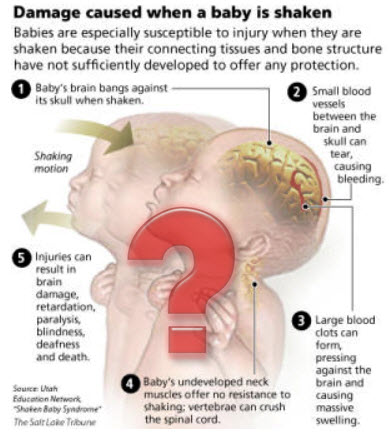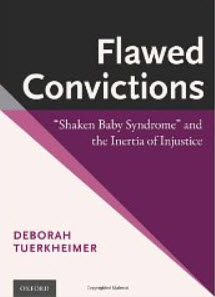Source of article Jury Insights.
What if “shaken baby syndrome” has nothing to do with shaking babies?

What if, for decades, well-intentioned but quixotic passions have created Kafka-like nightmares for hundreds of innocent parents, relatives, nannies, day care providers and other infant caretakers who have been wrongly convicted and imprisoned?
I recently learned of a controversy with implications as significant for reversing wrongful convictions in “shaken baby syndrome” child abuse cases as new DNA evidence has been for reversing wrongful convictions in certain murder and rape cases.
The British Nanny Case
You may remember a very famous “shaken-baby syndrome” case that occurred in 1997 involving a British nanny working in the United States named Louise Woodward. Woodward was a 19 year old English au pair charged with first degree murder of an eight month old child in her care in Massachusetts. A jury found her guilty of second degree murder, and she was sentenced to life in prison.Upon appeal, her conviction was reduced to involuntary manslaughter and time served of 279 days.
Dr. Barnes
Patrick Barnes, a pediatric radiologist at Stanford University, was a key prosecution witness in the trial. In 2011 he stated in an NPR broadcast that he wouldn’t give the same testimony today. He explained that, in the over 20 years since the Woodward trial, medical and scientific findings have yielded a new interpretation of brain bleeding and other clinical signs thought to be the result of care provider trauma.
The Drayton Witt Case
Drayton Witt of Tucson spent 10 years in prison, convicted in 2002 of shaking his girlfriend’s four month old son to death.
Dr. Guthkelch
He was saved from serving an additional 10 years when the Arizona Justice Project with support from Dr. Norman Guthkelch and other medical experts intervened to challenge the basis of the original conviction. As is common in many “shaken baby syndrome” cases, the baby had been born with health issues that impacted his entire short life, including multiple seizures. All charges against Mr. Witt were dismissed in October 2012.
Link: The Exoneration of Drayton Witt
Back in the 1970’s, Dr. Guthkelch, a pediatric neurosurgeon, became interested in the phenomenon of some babies bleeding atop their brains (subdural hematoma), despite little or no evidence of head trauma, bruising or other external injuries.
Apparently, when a colleague suffered similar bleeding after riding a roller coaster, Guthkelch surmised that whiplash-type movements could explain the clinical signs in these babies. He then extrapolated that the infants he had examined had developed subdural hematomas because they had been violently shaken by caretakers. He published a paper in 1971, warning parents about the dangers of shaking their children.
Truthiness
Sometimes, like Stephen Colbert’s “truthiness,” an authoritative speculation that is repeated can start to sound like documented fact. In the years that followed, despite the absence of eye witness support, evidence-based medicine support or biomechanical engineering support for the “shaking” causation theory, “shaken-baby syndrome” became widely accepted in the child abuse medical community.
Medical professionals began to teach medical students and social workers that the presence of a particular “clinical triad” of signs: subdural bleeding (blood collecting between the brain and the skull), retinal bleeding (bleeding in the back of the eye) and brain swelling, defined intentional criminal child abuse-“shaken baby syndrome.” Parents in baby care classes were warned to never shake a baby.
Guilty Until Proven Innocent
The “medical science” was then accepted into the criminal courts. A presumption of criminal guilt was established with the presence of the “triad,” even when there was no external bruising or other expected injuries (such as neck/spinal cord injuries) to the baby. When the “clinical triad” presented the last person with the baby prior to the 911 call was presumed responsible for causing intentional traumatic harm. The diagnosis of “shaken baby syndrome” became as close to a guilty until proven innocent proposition as one could possibly get.
Typical Case Progression
In the typical “shaken baby syndrome” criminal case a caretaker calls 911 because a baby suddenly went limp or stopped breathing. The hospital discovers one of more elements of the triad, and tells investigators that the infant was the victim of “shaken baby syndrome.”
The investigators confront the caretaker to explain how the subdural hematoma and other clinical signs occurred. The caretaker emphatically denies hurting the infant. When the caretaker cannot think of any accidental cause of the baby’s condition (no, there was not fall etc.), the investigator claims that the absence of other causes means that the caretaker caused the injuries. The caretaker is then criminally charged.
The pivotal medical-legal error appears to be the acceptance of the presumption of intentional causation through a misapplication of differential diagnosis. The assumption is that the presence of the “triad” without external signs of abuse can only be caused by whiplash traumatic harm, and once accidental trauma has been excluded by caretaker denials, the only explanatory trauma left is intentional harm.
Further, in the zeal to prosecute child abusers, many criminal cases go forward based on the one clinical sign of the “triad” alone, subdural hematoma.
The Accumulation of Doubt
Dr. Guthkelch now acknowledges that aspects of “shaken baby syndrome” are “open to serious doubt,” and questions the medical-legal conclusion of intentional traumatic brain damage when the “triad” occurs.
From 1987 to present, biomechanical engineering evidence and clinical evidence has not just challenged the notion of intentional criminal acts in some of these convictions– the new evidence has effectively challenged almost all convictions when there are no neck/spinal injuries or external clinical signs of abuse. (1) There has been little biomechanical engineering support for the “shaking” theory of causation of these injuries, especially without also causing neck/spinal cord injuries; and (2) there are many other alternative medical explanations for the cause of the “clinical triad” that have nothing to do with traumatic abuse.
Other the years there have been thousands of incidents of “shaken-baby syndrome” resulting in hundreds of convictions. For decades, criminal defense attorneys did not know how to defend these cases as the “shaken baby” diagnosis became so medically-legally interwoven as to be unassailable. More recently, because a cogent criminal defense requires medical experts rivaling the costs of civil medical negligence litigation, the defendant often has not had the resources to adequately respond to the prosecution’s witnesses.
As a result, there are scores if not hundreds of persons who may have been wrongly convicted of assault, manslaughter, and murder–many who are still serving decades long or life sentences in prison.
There has been growing support for the recognition of past errors in convictions, with several prosecutors and expert witnesses who formerly prosecuted “shaken baby syndrome” cases now working hard to right past wrongs.

Deborah Tuerkheimer, who used to prosecute these cases, has written Flawed Convictions: “Shaken Baby Syndrome” and the Inertial of Injustice that thoroughly reviews the problem and suggests policy solutions.
Unfortunately, the inertia of bad science that has previously been accepted by the courts is hard for many medical and criminal justice professionals to reject. The implications of entire communities of professionals acknowledging their participation in a tragic witch hunt and incarceration of innocent caretakers would be staggering.
Readjustment takes time, and many in the medical, social work and criminal justice fields maintain allegiance to the “shaken baby syndrome” clinical triad and continue to aggressively prosecute caretakers with well-intentioned passions, hoping to protect infants from further abuse and horrible injury.
The Trouble with Shaken Baby Syndrome — James Ross Gardener, Seattle Met 2014
Frontline Video 2011 – full video is available and can be downloaded.
Rethinking Shaken Baby Syndrome – NPR June 29, 2011
